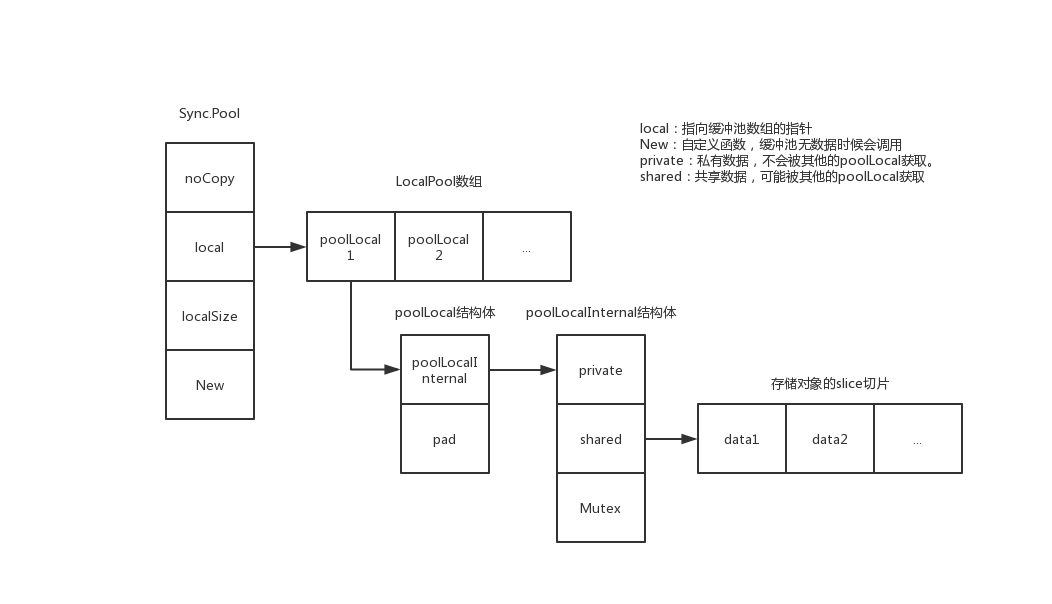我们通常用golang来构建高并发场景下的应用,但是由于golang内建的GC机制会影响应用的性能,为了减少GC,golang提供了对象重用的机制,也就是sync.Pool对象池。sync.Pool是可伸缩的,并发安全的。其大小仅受限于内存的大小,可以被看作是一个存放可重用对象的值的容器。 设计的目的是存放已经分配的但是暂时不用的对象,在需要用到的时候直接从pool中取。
任何存放区其中的值可以在任何时候被删除而不通知,在高负载下可以动态的扩容,在不活跃时对象池会收缩。
使用方法
1
2
3
4
5
6
7
8
9
10
11
12
13
14
15
16
17
|
func main() {
// 初始化Pool实例New
// New方法声明Pool元素创建的方法
bufferpool := &sync.Pool{
New: func() interface{} {
println("Create new instance")
return struct{}{}
},
}
// 申请对象
// Get方法会返回Pool已经存在的对象,如果没有,就走慢路径,也就是调用初始化的时候定义的New方法来初始化一个对象
buffer := bufferpool.Get()
// 释放对象
// 使用对象后,调用Put方法声明把对象放回池子。
// 这个调用之后仅仅是把这个对象放回池子,池子里的对象什么时候真正释放外界不清楚,不受外界控制。
bufferpool.Put(buffer)
}
|
Pool结构体
1
2
3
4
5
6
7
8
9
10
11
12
13
14
15
16
17
18
19
20
21
22
23
24
25
26
27
28
29
30
31
32
33
34
35
36
|
// A Pool must not be copied after first use.
type Pool struct {
noCopy noCopy
// 数组,对应每个P,数量和P的数量保持一致
local unsafe.Pointer // local fixed-size per-P pool, actual type is [P]poolLocal
localSize uintptr // size of the local array
// GC到时,victim和victimSize分别接管local和localSize
// victim 的目的是为了减少GC后冷启动导致的性能抖动,让分配对象更加平滑
victim unsafe.Pointer // local from previous cycle
victimSize uintptr // size of victims array
// New optionally specifies a function to generate
// a value when Get would otherwise return nil.
// It may not be changed concurrently with calls to Get.
New func() interface{}
}
// poolLocal管理Pool池里cache元素的关键结构,Pool.local指向这个类型的数组,
type poolLocal struct {
poolLocalInternal
// Prevents false sharing on widespread platforms with
// 128 mod (cache line size) = 0 .
// 把poolLocal填充至128字节对齐,避免false sharing引起的性能问题
pad [128 - unsafe.Sizeof(poolLocalInternal{})%128]byte
}
// 管理cache的内部结构,跟每个P对应,操作无须加锁
type poolLocalInternal struct {
// 每个P的私有,使用时无需加锁
private interface{} // Can be used only by the respective P.
// 双链表结构,用于挂接cache元素
shared poolChain // Local P can pushHead/popHead; any P can popTail.
}
|
这里的poolChain是一个双链表结构,里面包含了头插、头出、尾出的方法。

我们注意到Pool里是没有锁的,但是却实现了并发安全,这里我们详细看一下实现
pin
1
2
3
4
5
6
7
8
9
10
11
12
13
14
15
16
17
18
19
20
21
22
23
24
25
26
27
28
29
30
31
32
33
34
35
36
37
38
39
40
41
42
43
44
45
46
47
48
49
50
51
52
53
|
func (p *Pool) pin() (*poolLocal, int) {
// 把G锁住在当前M(声明当前M不能被抢占),返回M绑定的P的ID
pid := runtime_procPin()
// In pinSlow we store to local and then to localSize, here we load in opposite order.
// Since we've disabled preemption, GC cannot happen in between.
// Thus here we must observe local at least as large localSize.
// We can observe a newer/larger local, it is fine (we must observe its zero-initialized-ness).
s := atomic.LoadUintptr(&p.localSize) // load-acquire
l := p.local // load-consume
if uintptr(pid) < s {
return indexLocal(l, pid), pid
}
return p.pinSlow()
}
// 一般是Pool第一次调用Get的时候才会走进来(每个 P 的第一次调用)
// 把Pool注册进allPools数组;
// Pool.local 数组按照P的个数(cpu的个数)进行分配
func (p *Pool) pinSlow() (*poolLocal, int) {
// Retry under the mutex.
// Can not lock the mutex while pinned.
// G-M先解锁
runtime_procUnpin()
// 以下逻辑在全局锁allPoolsMu内
allPoolsMu.Lock()
defer allPoolsMu.Unlock()
// 获取当前G-M-P,P的id
pid := runtime_procPin()
// poolCleanup won't be called while we are pinned.
s := p.localSize
l := p.local
if uintptr(pid) < s {
return indexLocal(l, pid), pid
}
if p.local == nil {
// 把自己注册进allPools数组
allPools = append(allPools, p)
}
// If GOMAXPROCS changes between GCs, we re-allocate the array and lose the old one.
// P的个数
size := runtime.GOMAXPROCS(0)
// local数组的大小等于P的个数
local := make([]poolLocal, size)
atomic.StorePointer(&p.local, unsafe.Pointer(&local[0])) // store-release
atomic.StoreUintptr(&p.localSize, uintptr(size)) // store-release
return &local[pid], pid
}
func indexLocal(l unsafe.Pointer, i int) *poolLocal {
lp := unsafe.Pointer(uintptr(l) + uintptr(i)*unsafe.Sizeof(poolLocal{}))
return (*poolLocal)(lp)
}
|
runtime_procPin是procPin的一层封装
1
2
3
4
5
6
7
|
func procPin() int {
_g_ := getg()
mp := _g_.m
mp.locks++
return int(mp.p.ptr().id)
}
|
procPin函数目的是为了当前G被抢占了执行权限(也就是说,当前G就在当前M上不走了),
这里的核心实现是mp.locks++操作,在newstack里会对此条件进行判断
1
2
3
4
5
6
7
8
9
10
11
12
|
if preempt {
// 已经打了抢占标识,但还需要判断条件满足才能出让执行权
if !canPreemptM(thisg.m) {
// Let the goroutine keep running for now.
// gp->preempt is set, so it will be preempted next time.
gp.stackguard0 = gp.stack.lo + _StackGuard
gogo(&gp.sched) // never return
}
}
func canPreemptM(mp *m) bool {
return mp.locks == 0 && mp.mallocing == 0 && mp.preemptoff == "" && mp.p.ptr().status == _Prunning
}
|
这里的流程:禁止抢占GC->寻找偏移量->越界检查->返回poolLocal或加锁重建pool,并添加到allPool中。
放回Put
1
2
3
4
5
6
7
8
9
10
11
12
13
14
15
16
17
18
|
// Put adds x to the pool.
func (p *Pool) Put(x interface{}) {
if x == nil {
return
}
// G-M锁定
l, _ := p.pin()
if l.private == nil {
// Fast path:放回x到private
l.private = x
x = nil
}
if x != nil {
// 放到双向链表
l.shared.pushHead(x)
}
runtime_procUnpin()
}
|
放入流程
1、如果x为空,直接返回
2、获取localPool
3、如果private为空,把x放回private,并且把x置nil
4、如果x不为nil,将x放到pool的shared双向链表中
总结来说,优先放入private,后面再放入shared空间
取出Get
1
2
3
4
5
6
7
8
9
10
11
12
13
14
15
16
17
18
19
20
21
22
23
24
25
26
27
28
29
30
31
32
33
34
35
36
37
38
39
40
41
42
43
44
45
46
47
48
49
50
51
52
53
54
55
56
57
58
59
60
61
62
63
64
65
|
func (p *Pool) Get() interface{} {
l, pid := p.pin()
// fast path:从private去除缓存元素
x := l.private
l.private = nil
if x == nil {
// Try to pop the head of the local shard. We prefer
// the head over the tail for temporal locality of
// reuse.
// 从shared队列中获取,share的度量在Get获取,在Put投递
x, _ = l.shared.popHead()
if x == nil {
// 尝试从其他P的队列中获取元素,或尝试从victim cache取元素
x = p.getSlow(pid)
}
}
// 解除锁定
runtime_procUnpin()
// slow path:初始化对象
if x == nil && p.New != nil {
x = p.New()
}
return x
}
func (p *Pool) getSlow(pid int) interface{} {
// See the comment in pin regarding ordering of the loads.
size := atomic.LoadUintptr(&p.localSize) // load-acquire
locals := p.local // load-consume
// Try to steal one element from other procs.
// 从其他P中获取local
for i := 0; i < int(size); i++ {
l := indexLocal(locals, (pid+i+1)%int(size))
if x, _ := l.shared.popTail(); x != nil {
return x
}
}
// 从victim中取出对象
// Try the victim cache. We do this after attempting to steal
// from all primary caches because we want objects in the
// victim cache to age out if at all possible.
size = atomic.LoadUintptr(&p.victimSize)
if uintptr(pid) >= size {
return nil
}
locals = p.victim
l := indexLocal(locals, pid)
if x := l.private; x != nil {
l.private = nil
return x
}
for i := 0; i < int(size); i++ {
l := indexLocal(locals, (pid+i)%int(size))
if x, _ := l.shared.popTail(); x != nil {
return x
}
}
// Mark the victim cache as empty for future gets don't bother
// with it.
atomic.StoreUintptr(&p.victimSize, 0)
return nil
}
|
取出流程
1、获取poolLocal
2、从private中取出缓存元素
3、如果取出的元素为nil,则从shared中获取缓存元素
4、如果还为空,则从其他P的队列中取出元素
5、如果都取不到,则调用New方法初始化一个新的元素。
总结来说,优先从private空间拿,再从shared空间拿,还没有就从其他的poolLocal的shared空间拿,如果还没有就New一个返回。
定时清理
1
2
3
4
5
6
7
8
9
10
11
12
13
14
15
16
17
18
19
20
21
22
23
24
25
26
|
func init() {
// 在GC开始时,gcStart调用clearpools函数,也就是说每一轮GC都会对所有的Pool做清理工作
runtime_registerPoolCleanup(poolCleanup)
}
func poolCleanup() {
// 清理oldPools上的victim的元素
for _, p := range oldPools {
p.victim = nil
p.victimSize = 0
}
// Move primary cache to victim cache.
// 把local cache迁移到victim上
// 这样就不至于让GC把所有的Pool都清空了,可以防止抖动
for _, p := range allPools {
p.victim = p.local
p.victimSize = p.localSize
p.local = nil
p.localSize = 0
}
// The pools with non-empty primary caches now have non-empty
// victim caches and no pools have primary caches.
oldPools, allPools = allPools, nil
}
|
在每次GC时,把local移到victim中。
而runtime_registerPoolCleanup函数的具体实现在runtime/mgc.go中
1
2
3
4
5
6
7
8
9
10
11
|
func sync_runtime_registerPoolCleanup(f func()) {
poolcleanup = f
}
func clearpools() {
// clear sync.Pools
if poolcleanup != nil {
poolcleanup()
}
...
}
|
问题
1、为什么用Pool,而不是在运行时直接实例化对象?
原因:Go的内存释放是由runtime来自动处理,有GC过程
举个栗子
1
2
3
4
5
6
7
8
9
10
11
12
13
14
15
16
17
18
19
20
21
22
23
24
25
26
27
28
29
30
31
32
33
34
35
36
37
38
39
40
41
42
43
44
45
46
47
|
package main
import (
"fmt"
"sync"
"sync/atomic"
)
// 用来统计实例真正创建的次数
var numCalcsCreated int32
// 创建实例的函数
func createBuffer() interface{} {
// 这里要注意下,非常重要的一点。这里必须使用原子加,不然有并发问题;
atomic.AddInt32(&numCalcsCreated, 1)
buffer := make([]byte, 1024)
return &buffer
}
func main() {
// 创建实例
bufferPool := &sync.Pool{
New: createBuffer,
}
// 多 goroutine 并发测试
numWorkers := 1024 * 1024
var wg sync.WaitGroup
wg.Add(numWorkers)
for i := 0; i < numWorkers; i++ {
go func() {
defer wg.Done()
// 申请一个 buffer 实例
buffer := bufferPool.Get()
// buffer := createBuffer()
_ = buffer.(*[]byte)
// 释放一个 buffer 实例
defer bufferPool.Put(buffer)
}()
}
wg.Wait()
fmt.Printf("%d buffer objects were created.\n", numCalcsCreated)
}
// Output:
7 buffer objects were created.
8 buffer objects were created.
|
多次运行会出现不同的结果。
创建Pool实例的时候,只要求填充了New函数,而没有声明或限制Pool的大小。
如果不用pool来申请,而是直接变量声明的方式,会有1024*1024个对象生成。
这就是复用对象。
2、sync.Pool是并发安全吗?
A Pool is safe for use by multiple goroutines simultaneously.
当然并发安全。
因为sync.Pool只是本身的Pool数据结构并发安全,并不是说Pool.New函数一定线程安全。
Pool.New函数可能会被并发调用。
如果把atomic.AddInt32(&numCalcsCreated, 1)改成numCalcsCreated++,然后用go run -race main.go命令检查一下,会报出告警。
3、为什么sync.Pool不适合用于像socket长连接或数据库连接池?
- Pool池里的元素随时可能释放掉,释放策略完全由runtime内部管理
- Get获取到的对象元素可能是刚创建的,也可能是之前创建好cache住的,使用者无法区分
- Pool池里面的元素个数无法知道
总结
sync.Pool本质用途是增加临时对象的重用率,减少GC负担。
1、如果不是Pool.Get申请的对象,调用了Put,会如何?
Pool池中里的就不是单一的对象元素,取出的对象类型需要业务自己判断
2、为什么Get出的对象还要Put放回去?
通常是defer Put这种形式保证释放元素放回池子。
Get出的对象如果不Put放回去,会被GC释放,就不能复用临时对象了
3、Pool本身允许复制后使用吗?
不允许,因为有noCopy,但是可以编译通过。
因为copy之后,对于同一个Pool里面的cache对象,就有了2个对象来源。
Pool里面的无锁设计的基础是多个goroutine不会操作到同一个数据结构,Pool拷贝后就不能保证这一点了。

